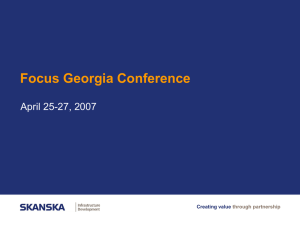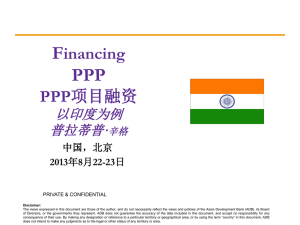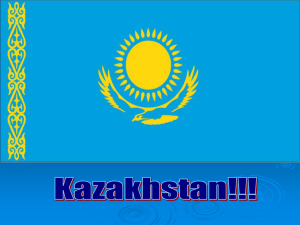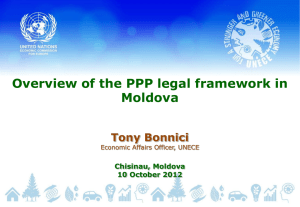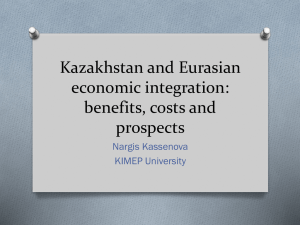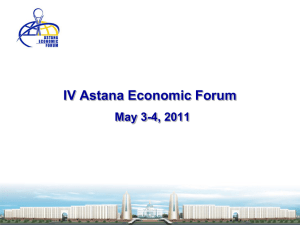Jill Jamieson
advertisement
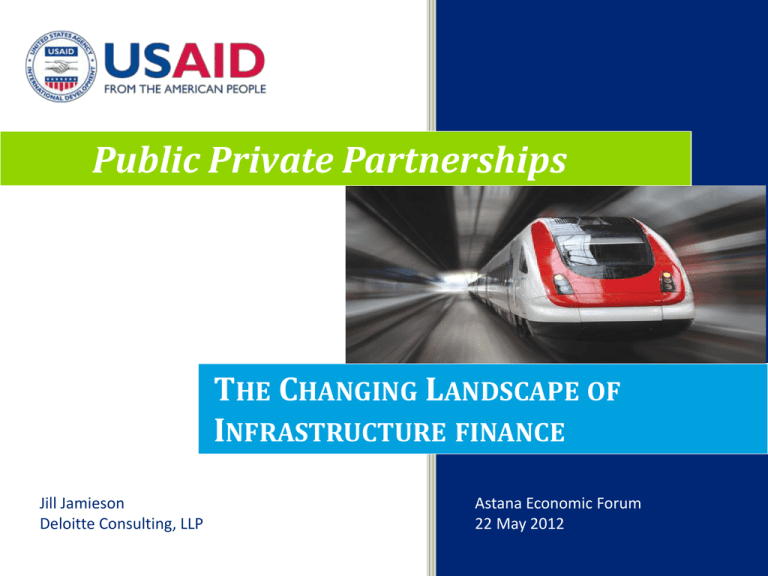
Public Private Partnerships THE CHANGING LANDSCAPE OF INFRASTRUCTURE FINANCE Jill Jamieson Deloitte Consulting, LLP Astana Economic Forum 22 May 2012 MEP PPP COMPONENT Market Maturity Curve by Country • Kazakhstan is still in early stage of PPP development High • Project design, legislative shortfalls and other factors have been key impediments in attracting international investors. Stage Three Sophistication UK Australia Spain Stage Two Canada Ireland Netherlands Italy New Zealand Greece Portugal Potential to Leapfrog France US Japan Germany Stage One China Hungary India Czech Republic Slovakia Bulgaria Latvia Croatia Russia Albania Kazakhstan Low Low Belgium South Africa Denmark Mexico Finland Brazil Activity High • Push for reforms : “PPP has a great potential to attract private investment - we launched this mechanism in Kazakhstan but it needs to be improved in accordance with international best practice.” – President Nazarbayev January 2010 2 GLOBAL CONTEXT • Kazakhstan is launching its PPP program at a very complicated time for infrastructure finance • Global investor flight to quality • Kazakhstan must consider the global infrastructure finance market if it hopes to gain credibility with global investors • While local investors may be an option in the medium term, Kazakhstan does not yet have the local financial infrastructure in place to launch a local PPP market • Kazakhstan’s New Finance Initiative makes the application of international best practice in PPP critically important to the country’s fiscal stability 3 CHANGING LANDSCAPE Financial crisis has changed the economics of PPP as financial transactions: Pre-Credit Crisis Trends Current Trends Demand • Limited public money available for infrastructure • Fiscal dynamics encouraging government to explore alternative delivery models Demand • Infusion of public money for infrastructure (stimulus) • Fiscal distress solidifying interest in alternative delivery models (austerity) Supply • Well functioning debt capital markets and international project finance loan market • Dominance of active equity investors and emergence of infrastructure funds Supply • Challenged debt capital markets • Price and tenor constraints in international project finance market • Impairment of some equity investors balanced by continued growth in infrastructure funds 4 RECENT CAPITAL STRUCTURES Capital Structure of recent PPP deals Transaction Date Value (US$ millions) Debt/Equity Ratio Embraport (Brazil) 11/2011 US$1,015 75/25 Lake Turkana Wind Power (Kenya) 4/2011 US$ $867.7 70/30 Pristina International Airport (Kosovo) 6/2011 US$186 65/35 Florida I-595 (USA) 3/2009 US$1,670 87/13 St. Petersburg Pulkovo Airport (Russia) 6/2010 US$1,600 60/40 Karaganda Kindergarten Concession (Kazakhstan) 10/2011 US$40 0/100 5 INFRASTRUCTURE INVESTORS Strategic buyers / Concessionaires • • • • Traditionally, sector operators, developers or contractors Benefit from sector expertise, which can enhance the VfM Long-term investment strategy Always take part in consortium (to control results) Infrastructure Funds • • • • • • Equity funds focused on infrastructure investments Strong liquidity awaiting investment opportunities Lower equity returns than for financial sponsors Typically look to take part in a Consortium Medium to long-term investment Smaller investments than financial sponsors • • • Equity firms with short exit strategies High equity returns may limit value-for-money Normally look for short-term investments with clear exit strategies Typically take part in a consortium Financial Sponsors • 6 CURRENT TRENDS PPP is being employed as part of both austerity and stimulus programs Investors are in pursuit of quality transactions Known strategic partners / concessionaires Transparency and balanced risk Innovation in risk distribution has revitalized investors in some areas Infrastructure funds are dominating the markets Sector preferences (i.e. clean energy) are jump-starting PPP programs Increased emphasis on fiscal impact of PPP 7 RECOMMENDATIONS Global crisis has evidenced a strong flight towards quality projects, so if Kazakhstan hopes to attract serious foreign investment, it must place more emphasis on transaction design: Hire qualified transactions advisors Seek balanced risk allocation Insist on transparency in procurement Ensure contractual and regulatory compliance Undertake legislative reforms, but with an aims towards: Simplification of the legal framework Overcoming known deficiencies in legal framework Drive legislative reform through pilot projects Desperate need for Institutional reform: Institutional structure for PPP in Kazakhstan is an obstacle to investment Approval processes are excessive and ineffective Pilot Projects Enable line ministries and regions for project development 8 USAID Macroeconomic Project
